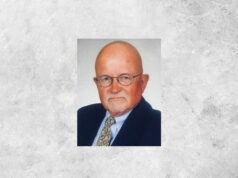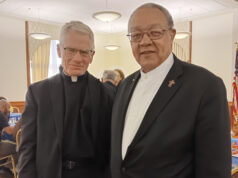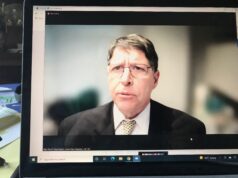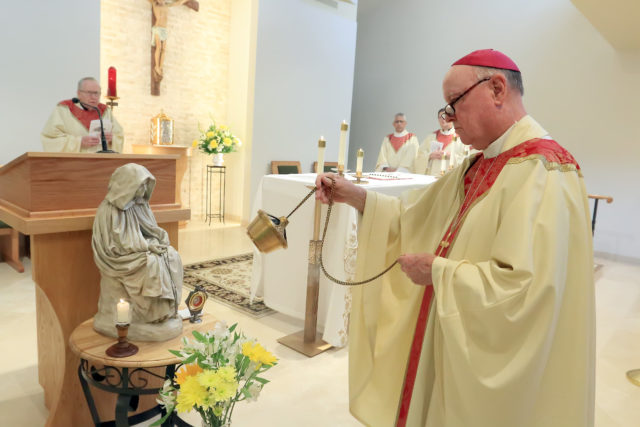
Bishop W. Francis Malooly submitted his retirement letter to Pope Francis in January when he reached his 75th birthday, as required by canon law. Dialog staff writer Mike Lang has covered the entirety of Bishop Malooly’s tenure in Wilmington. The bishop sat down with Lang in October to reflect on his time in Wilmington and talk about his future plans.
The Dialog: You submitted your letter in January, and here we are, nine months later, still waiting. You knew it wasn’t going to be right away.
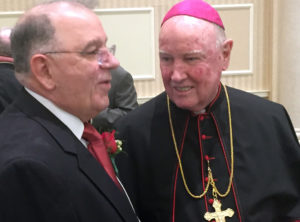
Bishop Malooly: There are 12 guys born in ’44. Many of these dioceses are going to have to go through look-back legislation (opening a window for civil lawsuits to be filed for clergy sexual-abuse cases). So, do you keep the same guy in for three years to get through all that, or do you replace him right away, and who’s going to want to take the job? Now, this will be an easy ride here because we did all that. But my friend Bishop (Richard) Pates in Des Moines, he was 18 months past his birthday, and Helena just recently, they were 21 months. Anyway, nine months does not surprise me, and it could be another nine or 12 months, or it could be tomorrow.
The Dialog: It’s not like you submit this letter and you sit around waiting for the phone call. You go about your business.
Bishop: Exactly. I got a response back from the apostolic nuncio saying that the Holy Father accepts my resignation, and it will be effective when he replaces me. It’s called nunc pro tunc, now for then. So, basically, I got an email back that he will accept this, and that it will take effect once there is someone to replace me.
The Dialog: You don’t look anxious. This was just something you had to do.
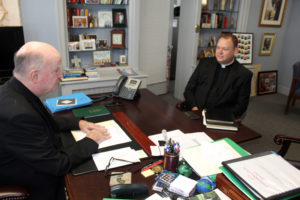
Dialog photo/Joseph P. Owens
Bishop: One day at a time, Michael. I was in my thirties when I first took over clergy personnel, 39. I’ve been in charge of everything I’ve done since then, so I don’t think I’ll have a problem backing off and not being in charge. I don’t have a big ego, so it shouldn’t be a big deal. I’ll just take each day as it is. We sent all the materials over about the status of the diocese. Back probably seven months ago, we pulled together everything we needed so they could send it to the nuncio who will send it in to the Congregation for the Bishops, and that would help them to discern who would be the best person for this particular position.
The Dialog: We’re going to go a bit backward. Do you have any big plans for when you retire? Are you going to travel or go see some of your priest friends, or are you just going to hang out here in Wilmington and Baltimore?
Bishop: Well, I have my own home. The only thing I have to do once the announcement comes is move out of this office. It will be pretty simple, and we’ll get it redone. It hasn’t been redone since Saltarelli’s time. I was telling someone a couple of days ago; we have a lot of interesting areas in the diocese that I’ve never seen. Winterthur. I love Chestertown, Washington College. Basically, I’m a circuit rider. If I go down to Chestertown, I’ll go to Centerville. I’m never in a place more than a couple of hours for confirmation. I’d really like to see – I’m not a traveler by nature – but I’d like to see some of the diocese. Delaware City, down the end of the pier there. Usually, if I go there for confirmation, I go down a couple minutes early just to drive down and take a look. I think I’ll just travel the diocese.
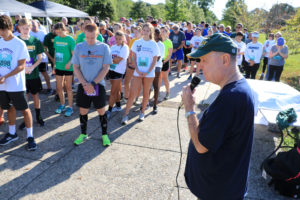
I’m assuming the new bishop will want to do everything the first year. He’ll probably want to do all the confirmations and all the other celebrations that are on my schedule now already. I assume he would want to visit all the schools, as I did in my first year and still do. Basically, my experience from being on a staff with two archbishops being replaced in Baltimore is that the archbishop stepped back, and the new archbishop became center stage and got to know the people and the diocese. I’m assuming my first year would be pretty low-key. I would help out in parishes for Masses when needed. He might want me to do a couple of confirmations, but it will be his call.
I would encourage him to not share the load with me too much. If I do three or four confirmations, the parishes are going to think they’re second fiddle or whatever. We’ll see how it plays out.
My family is about an hour and 40 minutes away. They usually come up here because we have family gatherings at my brother’s house, and I just can’t make them. So, I’ll be able to do more of the family gatherings, and I’ll be freer to have them come up.
The Dialog: When you came to Delaware, were you familiar with Delaware?
Bishop: Actually, Mike, I was not familiar with Delaware itself. New Castle County was new to me. I was familiar with Ocean City and Bethany because we vacationed there from my teenage years on. I knew some of Delaware because I always dreaded the Bay Bridge to get to the ocean. So, I would come up 40, before 95, over 896, which was a small country road going through Glasgow then, and down 13. So, I had this sense of cute, little small towns. Of course, this goes back to the 60s and 70s.
The Dialog: Were you surprised by anything when you got here or after you’d been here for a little bit?
Bishop: It is a small, quaint area. The reason I would stay here is two-fold. The first is almost every bishop stays in the diocese where he’s assigned because it becomes his home. But also, after growing up in Baltimore, it’s just so laid-back here. My drive to the office is four miles and eight minutes through a golf course. It’s just a very relaxing setup except when I’m on 95 or 1. It’s just easily accessible.
We have so many beautiful parks here. I’ve been to Bellevue, we had our first 5K there. Where we were this summer, Glasgow, is a beautiful park also.
The Dialog: People are people no matter where you go, but everybody seems to have welcomed you.
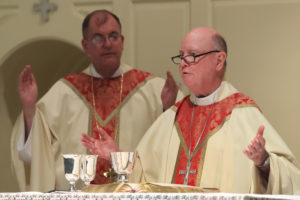
Bishop: It’s interesting. I drove up the night before the announcement. I talked to the bishop. I was going to get together and meet with him and then Msgr. Barres, and he said, ‘No, no, we’ll come down to you.’ I really wasn’t here between the months of July 7, when I was here for the announcement, and Sept. 8 when I was installed. The day of the announcement, July 7, I drove in, and I saw St. E’s, St. Hedwig’s and St. Paul’s, and I asked Bishop Saltarelli, ‘Are any of those our churches?’ And he said, ‘All three are.’ So, in the ensuing 11-plus years now, whenever I come up 95 and get to Martin Luther King Boulevard, get to that area, I always know I’m back home because I see the three churches. Just the image is very nice for the city.
The Dialog: Is there anything you didn’t expect?
Bishop: I knew what I was getting into. It was the middle of the look-back legislation. I’d been dealing with the abuse crisis since 1984. There were no real surprises. I was concerned about Catholic education, as I still am, and keeping Catholic education as strong as possible. We were already dealing with that in Baltimore City. But I can’t say there was anything that was …
We’re part of the Baltimore province, and we’re members of the Catholic Conference. I knew all the leaders. I knew the bishop. I knew Msgr. Cini from seminary. I knew Msgr. Barres from the Maryland Catholic Conference.
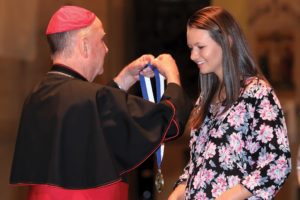
I’ve known four of my predecessors. I met Bishop Hyle when I was a seventh-grader because he would come back to Baltimore after the Christmas and Easter holidays, and he would stay at the parish where I grew up because the pastor there was his best friend. I knew Mardaga because I was in theology when he was transferred here as an auxiliary. Of course, I worked closely with Mulvee and Saltarelli under Archbishop Borders and Cardinal Keeler. There wasn’t too much that was new.
The Dialog: You mentioned the abuse situation. You came in right smack in the middle of it. You knew what you were getting into.
Bishop: I knew what I was getting into. I didn’t expect it to be so widespread. There were 30 survivors who had come forth in the first year, and we ended up with 165. Having said that, we’re going back to 1940. Every case of abuse is horrible. It’s a crime. A sin and a crime. But the numbers kind of surprised me. From the ’40s to the late ’70s, that’s when most of it took place. ’93 was the last known case reported here. Will other things pop up? Possibly.
To wrap my arms around it, even when we released the list of names in Baltimore in 2002 – I think we were the first diocese to do that – most of it took place in the ’40s, ’50s and ’60s.
I think in our child protection, (Office of Safe Environments Director) Mike Connelly does an outstanding job. Our child-protection services here have been really well done. It doesn’t mean something doesn’t happen tomorrow. You could wake up, anything could happen. You just don’t know. It’s happening around us, it just isn’t happening within us.
I was surprised at the numbers because there weren’t many bankruptcies up to that time. Milwaukee followed us. You just didn’t pay attention to the numbers. In hindsight, I’m glad everyone came forward, everyone who did. We could never make up for the crimes, but it was at least good to be able to try to address what was happening.
The Dialog: With the bankruptcy, when you look back, do you think that was the best way to do it, or do you think there were ways we could have done it otherwise?
Bishop: There’s no question. Bankruptcy was the only way. I’m 75 now. This was 10 years ago, I’m 65. Most of the survivors were in my age group. If we did four or five trials at the time, to get to 165, two things. We would run out of resources, number one, and then number two, many would not live long enough. By doing the bankruptcy, we were able to fold the diocese and the parishes in together. The trial we had at St. E’s, it was a $3 million verdict, with five more trials to come, which means that’s all gone if we hadn’t folded it all together.
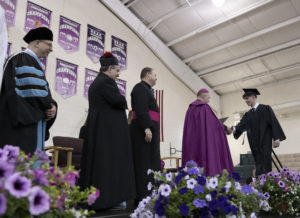
I think it was the fairest thing to do for all the survivors. It helped us to retain our ministry, not as effectively as we would like, but we had to deal with these problems that were caused by my brothers. You’re going to lose something in that, and that’s appropriate given the crimes that were committed and how devastating they are for any one of the survivors.
The Dialog: You look back and see how the diocese has emerged from the bankruptcy, and obviously some things were lost, but do you think the diocese has survived itself?
Bishop: We’re about 25 percent lighter, staff-wise. We have smaller departments. Our religious ed department is two people. Some parishes have more than two people running religious ed. Our schools office is small compared with the 19 public school districts in our state. But all of our groups are very effective. That, to me, that’s the key. We have quality people in all positions and that’s a significant plus for us.
I have to say I was surprised at what happened with the capital campaign. We were told we couldn’t raise $28 million, but we had no choice. The pastors really stepped up. I talked to the major donors. I said we were all very generous to the collection for the retired religious who taught us in school. Now we’re trying to take care of the teachers who taught your children and are teaching your grandchildren who are lay men and women. I think people resonated with that. It was mostly pensions and not a lot of brick and mortar, which usually capital campaigns are. That was very encouraging to see, how the pastors were able to work that through.
The annual appeal each year has been very successful. The numbers this year will be slightly lighter than past years, but it’s always gone over goal. Once again, that’s a tribute to the pastors and to the generosity of the people, especially in this day and age with all the havoc going on in the church. So, I’ve been impressed.
The Dialog: You had a few goals that you kind of laid out. Have you been able to assess those?
Bishop: The bankruptcy was one week after Bishop Saltarelli died, which was 13 months after I got here. That whole first year was trying to deal with the issues that we had to deal with. It wasn’t to set some major goals because, once again, we knew that we were going to be a lighter operation simply by sheer mathematics.
I guess it was probably ’11 or ’12 when we put out the first major goals. Like most dioceses, Catholic schools and education are significant to me. Vocations are very important. Staffing of parishes. We are fortunate that we have primarily very small parish communities. Priests have been able to do two of them. It’s a workout, but when I came from Baltimore, of the 44 parishes that I was responsible for in the western six counties, 10 did not have a priest pastor. Priests would come over from the universities in D.C. on weekends to do Mass. We’ve been very fortunate here with the priests we have and their willingness to stretch beyond what you would usually expect.
We have nine seminarians this year. These are really good, academic, spiritual men. I’m really pleased with that. Michael Preston will be ordained a deacon this spring and then a priest the following year.
The Dialog: I know every bishop likes doing ordinations. You may not be able to do the next one.
Bishop: I’ll attend it. That will be fine. Any time there’s an ordination here in Wilmington, I’ll be there because it’s going to help the diocese. There’s no question.
The Dialog: I was at one at Salesianum, for Father Mike Vogt. It was a neat experience.
Bishop: It was. It was good for them. They still talk about that. When Father Greenfield asked if I’d be willing to do it, I said yeah. Bishops get installed in civic centers. If we can do that for bishops’ installations. And, of course, that was his primary community. That and his family. Our priests have been ordained at the cathedral primarily, but not always. If we have multiple priests, we’ve used other parishes.
The Dialog: To what extent were you able to meet your goals?
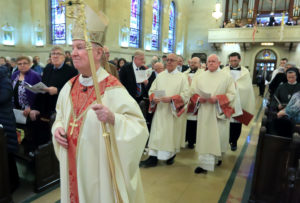
Bishop: I think we did pretty well. We were looking at ways to staff parishes. I didn’t want to get into lay leaders right yet. I wanted a priest-pastor in every place if I could. But that was an option. We have a lot of wonderful lay leaders, so that’s not a problem. I had that model when I was in Baltimore in the ‘90s and 2000s. It worked OK, but I think there’s just something about having a priest-pastor that’s a little bit different and then having other staff people who also have other responsible positions. We tend to have small parish staffs because we have small parishes. Which is good. I have no concern with that.
In Catholic schools and religious ed, I think we’re doing OK. To me, if I had something where I had to pass the baton, I hope the new bishop will look seriously at how we increase tuition assistance. I think that’s the key. Tuition is hard for parents to do, and yet, we can’t run schools without tuition. When we don’t have it, that’s when schools close. So that’s important to me.
And basically, the joy of ministry. Right from the beginning, ‘Rejoice in the Lord’ has been my motto now for 19 years. We used that last year for the convocation and also for our anniversary year. I just think the more we can be welcoming and invite people … When I was ordained in 1970, I was at a 3,000-family parish. We weren’t thinking about 3,005 families or 3,010 families. It wasn’t, you know, maintenance, but it was close. We need to reach out and welcome people and reach where they are. I think the parish pastors have picked up on that very nicely.
The Dialog: You mentioned the sesquicentennial last year. You started the cross pilgrimage.
Bishop: We started that in ’10. It took a year to get that off the ground. That went back to the ’80s with Cardinal Keeler when he was in Harrisburg. The pope had encouraged that after the first World Youth Day, I think in ’84.
The Dialog: Any things you brought in or started when you got here that you look back and say, ‘That wasn’t a bad idea’?
Bishop: I think the pilgrimage. We had done it in Baltimore, and I thought it was a very valuable tool with our young people. The beauty of this area is that with the number of Catholic grade schools and six Catholic high schools (in New Castle County), so many of the kids know each other. From mock trial and the musicals and plays, it’s nice to get these kids together who might be in different high schools now but came from similar grade schools. It’s a good day for us, the Saturday before Palm Sunday.
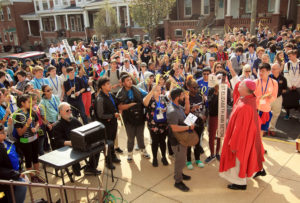
Different models of trying to deal with vocations. Father Carroll’s done a tremendous job as our most recent vocations director, and the other priests. This is something where I was hoping that not only the vocation director would be involved, but every priest would be thinking about vocations. And that mindset is pretty much here. I think the whole vocation thing has … we have a wider group of people who are anxious to support vocations.
The Dialog: The convocation last year was a big deal. Do you feel fortunate that you were able to be here for that?
Bishop: That was put together by the staff, not by myself, obviously. The theme, “Rejoice in the Lord,” was part of my repertoire or my personality. We had great speakers, many of whom I knew, like Bob McCarty. I thought that went very well. We were fortunate to have many of the parish leaders there. I was glad we did it in Ocean City because we do most things up here in New Castle County because it’s the biggest Catholic area. It was well-planned. I was very pleased with that.
The Dialog: You talked about the Catholic schools. Obviously, the enrollment is not what it used to be. When you look at the state of Catholic education overall, do you think it’s in decent shape?
Bishop: We’re similar to any diocese in the country. There are 195 dioceses. The average loss each year is about 3 percent. We only had one and a half this year, but we picked up a lot of 3-year-olds, so you have to mix the apples and oranges to get the real figures. We always have a school or two that is struggling, but I’m not worried. I think the presence here in the city is strong. We have to keep our schools in areas like Salisbury and Ocean Pines – where there’s no other game in town – we have to keep those schools strong. We’ve been fortunate where we’ve been forced to close or merge schools, we’ve been able to get many of the students to go to a new school. It’s just part of what’s going to happen.
To me, in order to maintain the environment and the Catholic atmosphere of the family, Catholic school is pretty critical. Religious ed is, too, but that’s a shorter program, less hours per year. Having five days a week in a Catholic school, in that environment, not only teaching religion but living it out, is, to me, so critical.
The Dialog: Sometimes, the raw numbers don’t tell the whole story.

Bishop: The real shock to me when I came here was the quality of education across the board. I came from Baltimore city where we had 21 PIE schools, partners in excellence. They were 95 percent African-American, 85 percent non-Catholic, supported by businesses because they considered them non-sectarian even though like out at our cathedral school we teach religion even though the kids aren’t Catholic.
I come here and I see Catholic schools that are outstanding, I see private schools that are outstanding. I see some of the 19 public school districts do very well, and the charter schools. Saint Mark’s went down because Newark Charter is so good. Once Newark Charter started the high school years, I think we lost about 35 kids a year who would go to Newark Charter to Saint Mark’s. Once again, both schools are providing a really good education. I prefer the Catholic model, but I want the kid to have the best education he or she can get.
I feel fortunate that we have schools in this diocese – in Dover, a lot of kids don’t go to Thomas More because they have really good vo-tech and public schools. In Sussex County, the schools are beautiful. The state seems to be pretty good with education.
The Dialog: You made it a point to travel to all the schools and all the parishes. I guess you feel it’s pretty important for the kids to see you, that you’re not a guy in an office at confirmation and that’s it.
Bishop: I like it. Lou (De Angelo) and I do it each year, this is the 11th year, for a couple reasons. One, it’s nice to interact with the kids, to get to know a good number of them. And by the time we get to confirmation age, many of them I do know. But the other reason I do it is an affirmation for the parents. I want them to know how delighted I am that they are willing to sacrifice so that their child can get a Catholic education. Even our small places like Good Shepherd, they do very well in high school and college. The quality of the education in our schools is very good. I know those kids are well-prepared for high school and college and life.
The Dialog: So how many miles a year do you put on your car?
Bishop: You know, that’s interesting. We try to pocket the travel so that it’s not up and down, up and down. It might only be 12 or 14,000. I did more in Baltimore. What happens is like in May, I’ll cover the schools in Easton, Salisbury and Ocean Pines. I’ll do confirmation in Salisbury, I’ll do the four parishes from Ocean Pines to Bethany at St. Luke’s. I’ll do the four parishes from Rehoboth up to Georgetown at probably Millsboro or one of the parishes. I’ll go down for three or four days the first week in May.
The Dialog: This is your second car since you’ve been here.
Bishop: I had the Honda Accord. I would get one every 10 years in Baltimore and save money for the next one, then give it to whatever nephew or niece needed a car. I came here and still had the Honda Accord. It was great for the mountains of western Maryland. But it wasn’t as good for 95. You couldn’t see as well. It was too low. So that’s when I went to the Honda CRV. That’s been very good.
The Dialog: You have one more visit with your boss in December.
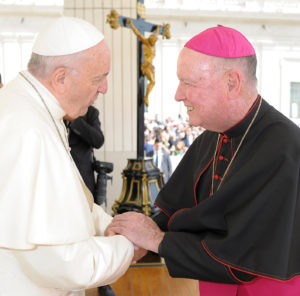
Bishop: Yes, we go over in December for the ad limina. Msgr. Hurley will go with me. It will be the province of Baltimore, which is the Archdiocese of Baltimore, Arlington, Richmond, Wheeling-Charleston, the military archdiocese, and the Washington archdiocese, and Bishop (Herbert) Bevard, who’s the suffragan. He’s in the Virgin Islands.
The Dialog: So, you’re waiting for that assignment, the Virgin Islands?
Bishop: No, I don’t need to start a new assignment. I’m in good health. The doctor gives me good grades, so I should be around a while to help out. I’ll be happy to stay right here.
I went on the ad limina in 2004 with John Paul. I went as the auxiliary with Cardinal Keeler, and then in 2012, I met with Pope Benedict. This will be interesting. It’s a different dynamic they’re using. But it’s always good to get together with the other bishops.
The one thing I noticed early on here was that I missed having the camaraderie of having the other bishops around. Not that the priests weren’t good to me and weren’t always welcoming. They were. But in Baltimore I was used to working with the archbishop. We usually had a retired archbishop. I was often one of three auxiliary bishops. You had fellows who were dealing with the same issues. You kind of got some support on that level. I did miss that when I first came here.
The Dialog: It used to be every five years.
Bishop: The ad limina was every five years, but with the older pope, St. John Paul II, you kind of lost a couple of years. Pope Benedict was older also. And then Pope Francis, he’s just all over the place. I think when they started traveling, that kind of changed the dynamic. I think every eight to 10 years is more pragmatic. We have contact with the different congregations anyway. And all of us have a good rapport with the apostolic nuncio.
The Dialog: Pope Francis was here in 2015 for the World Meeting of Families.
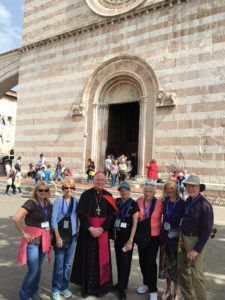
Bishop: I met him in Washington at St. Matthew’s Cathedral because I was part of the administrative team. He always says the same thing, ‘Pray for me.’”
Each (pope) is unique. John Paul was so dynamic and had that flair about him, having been an actor and all that. I met him 20 times. Pope Benedict was very warm and personable, more one-on-one. And Pope Francis has a warmth about him, too. Each brings slightly different gifts, but probably the gifts for the time.
The Dialog: So you’re not up for that job?
Bishop: I don’t look good in white.
Honestly, it’s been a good ride. I wouldn’t trade it in. I don’t mind troubles and challenges. It’s been a good 10-and-a-half years, and if I knew what I know now back then, I still would have done it. There are so many pluses.
I knew a third of the priests when I got here. It’s just the right size to get to know a lot of the people and all the priests.





